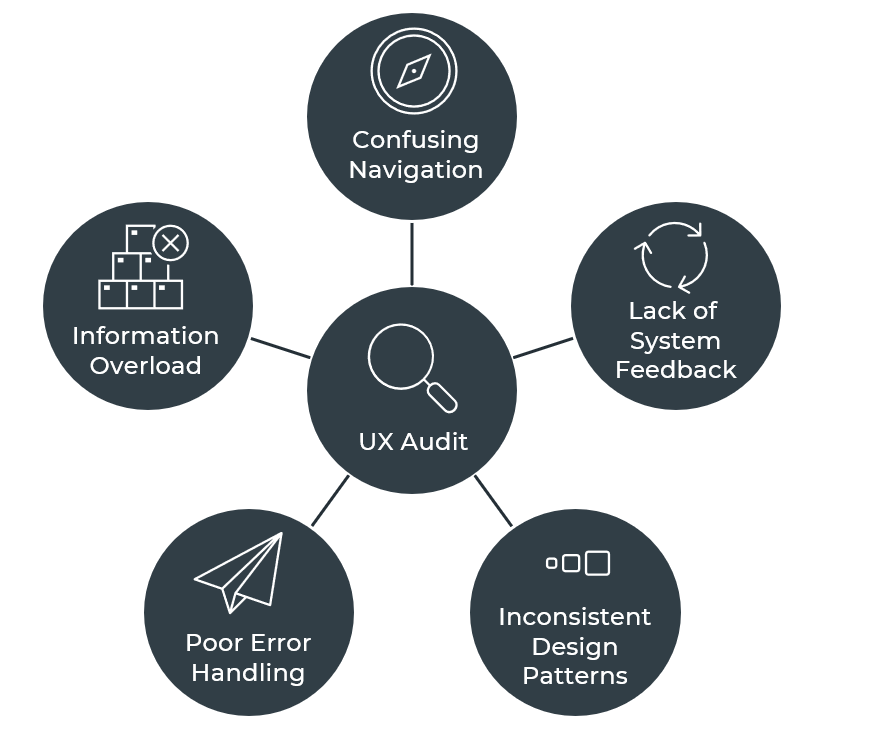While every digital product is unique, our experience conducting UX audits for a wide range of companies has revealed a surprising truth: most products, regardless of industry, suffer from a handful of the same common, fixable usability issues. These problems act as silent barriers, frustrating users and hurting your key business metrics.
Often, the teams that build the product are too close to it to see these foundational flaws. At Cardinal Peak, our job is to provide that expert, objective perspective. Here are the top five most common usability issues we uncover during a user experience audit.
Figure 1. A professional UX audit is the most effective way to identify and prioritize the common usability issues that may be hindering your product’s success.

Contents
1. Confusing Navigation and Information Architecture
- The Problem: Users can’t find what they’re looking for. Key features are buried in illogical menus, and the terminology used for labels and navigation is inconsistent or unclear.
- The Impact: This leads to immediate user frustration and task abandonment. If a user can’t find a feature, it’s as if it doesn’t exist.
- How to Fix It: A key part of our UX review involves mapping out the existing information architecture and comparing it to user mental models. The solution often involves simplifying the main navigation, creating clearer labels, and restructuring content to match user expectations.
2. Lack of System Feedback
- The Problem: A user performs an action—like clicking a button or submitting a form—and the system provides no immediate, clear feedback to confirm the action was successful.
- The Impact: This leaves the user in a state of uncertainty. Did my form submit? Is the file uploading? This uncertainty erodes trust and can cause users to repeat actions unnecessarily.
- How to Fix It: Implement immediate and clear feedback mechanisms. This can be as simple as a “Success!” message, a loading spinner, or a subtle color change on a button after it has been clicked.
3. Inconsistent Design Patterns
- The Problem: The same types of elements look and behave differently throughout the product. A primary action button is green on one page and blue on another; some links are underlined while others are not.
- The Impact: Inconsistency increases cognitive load. Users have to re-learn how the interface works on every new screen, which makes the product feel unprofessional and difficult to use.
- How to Fix It: The solution is to develop and adhere to a consistent design system or style guide. This ensures that all UI elements are used consistently, creating a predictable and seamless experience.
4. Poor Error Handling
- The Problem: A user makes a mistake, and the resulting error message is vague, technical, or accusatory (e.g., “Invalid Input”). The message doesn’t explain what went wrong or how to fix it.
- The Impact: Blaming the user for an error is a cardinal sin of usability. Unhelpful error messages lead to frustration and can cause the user to abandon the task entirely.
- How to Fix It: Write clear, helpful, and polite error messages. The message should explain the problem in plain language and provide a constructive suggestion for how to resolve it.
5. Information Overload (Cognitive Overload)
- The Problem: A screen is packed with too much information, with no clear visual hierarchy to guide the user’s attention. Everything is competing for focus.
- The Impact: When faced with too many choices, users often make no choice at all. This “analysis paralysis” can overwhelm the user and prevent them from finding the information or feature they need.
- How to Fix It: Use visual design principles like whitespace, color, and typography to create a clear hierarchy. Guide the user’s eye to the most important elements on the page first, and use progressive disclosure to hide secondary information until it’s needed.
Conclusion: From Common Problems to a Competitive Advantage
These common usability issues can silently undermine your product’s success. The good news is that they are all identifiable and fixable. A professional UX audit service from Cardinal Peak is the first step. We provide the expert, third-party perspective needed to diagnose these problems and deliver a prioritized, actionable roadmap to turn your product’s weaknesses into a powerful competitive advantage.
Find and Fix the Hidden Barriers in Your Product
These common usability issues can frustrate users and hurt your bottom line. Our comprehensive UX audit provides an expert, objective analysis and a prioritized roadmap to fix them. Let’s unlock your product’s true potential. Request an audit consultation.
